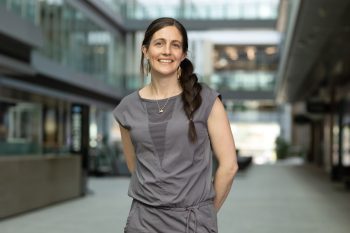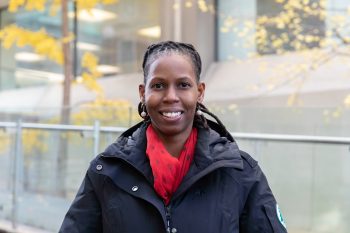U of T Engineering students Cassandra Chanen, Jacqueline Fleisig and Zhengbang Zhou (all Year 1 EngSci) knew they would work on a design project — but they didn’t anticipate taking on a major social issue.
The team of first-year Engineering Science students is one of three groups applying engineering approaches to redesign naloxone kits. Naloxone is a drug that can quickly reverse the effects of an opioid overdose. Pharmacies give the kits out for free and many public spaces, such as libraries, bars and community centres, keep them on hand in the event of emergency.
The current kit design requires about 20 to 30 minutes of training with a pharmacist, and requires users to follow complex instructions and draw up medication into a syringe from a tiny vial. Chanen, Fleisig and Zhou estimate that their improved design could see naloxone administered about twice as fast.
“If you’re in a nightclub setting, not only is the other person on drugs, but you might be too,” says Chanen. “For example, if you’ve taken a stimulant you’re likely to have hand tremors that make drawing up the medication difficult. We tried to consider these sorts of external factors in our design.”
The team did extensive research on instructional design, including optimal fonts and colours for ease of use, and physiological response to substances. They consulted with front-line workers at safe injection sites and with local business owners about their experiences with the current kit design.
“The opioid crisis is an urgent problem affecting thousands of people,” says Chanen. “We saw this course as an opportunity to work on something really relevant to people of all ages, but especially our age.”
The Praxis course challenges students to explore their city and collaborate directly with communities, businesses, social services and governments to identify challenges that could benefit from engineering design thinking. In addition to redesigning naloxone kits, students took on a range of issues for a diverse mix of clients, including:
- Improving privacy of a rooftop ceremony space — Native Child and Family Services of Toronto
- Improving the waiting experience for patients in the Respiratory and Thoracic Surgery Clinic— Toronto General Hospital
- Helping Parkinson’s patients dance with dignity — Dancing with Parkinson’s
- Supporting music for everyone — Toronto Music Therapy Centre
- Developing a system for counting the usage of non-circulating materials— Toronto Reference Library
- Inventing a request-for-assistance system— Kensington Gardens Residential Home
- Designing a storage facility for coffee beans— The Coffee Lab
- Improving toy hygiene and disinfection processes— The Pediatric Group Clinic
- Timing the throw in a quick knife-draw competition— Stryke Target Range
“This year students worked well with communities on socially important and urgent projects,” said Professor Alan Chong (Engineering Communications Program). “We try to encourage civic engagement in our students, and I think that’s an ideal direction for this course to be taking.”



